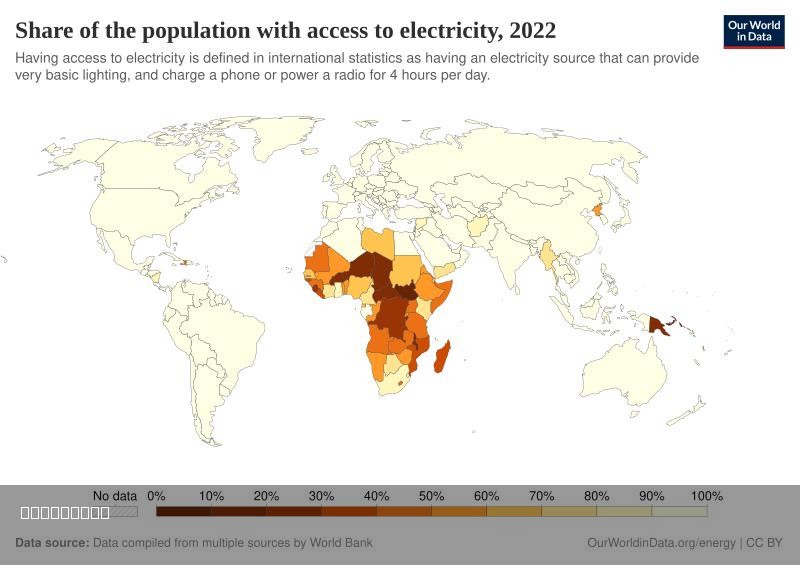Access to Electricity in 2022 Map


David Chen
Data Visualization Specialist
David Chen is an expert in transforming complex geographic datasets into compelling visual narratives. He combines his background in computer science ...
Geographic Analysis
What This Map Shows
The "Access to Electricity in 2022 Map" provides a clear visual representation of the global landscape regarding electricity access across different countries. This visualization highlights the stark contrasts in electrification rates, particularly emphasizing the regions where access remains significantly low. The data reflects a troubling reality: while developed nations like the United States, England, and Japan achieved near-universal electrification by the 1930s, many countries in sub-Saharan Africa still face significant challenges. In fact, with the exception of Ghana, Kenya, and Gabon, most countries in the region have electricity access rates below 80 percent.
This map serves as a stark reminder of the disparities in energy access and the implications for development, quality of life, and economic opportunity.
Deep Dive into Electricity Access
Electricity is a fundamental component of modern life; it powers our homes, schools, and industries, facilitating communication and innovation. However, the global access to electricity remains uneven. According to the International Energy Agency, as of 2022, approximately 733 million people worldwide still live without electricity, with the majority concentrated in sub-Saharan Africa.
What's fascinating is that the timeline of electrification varies significantly by region. Developed countries have long enjoyed the benefits of widespread electricity access, achieving nearly universal coverage by the 1930s. In contrast, middle-income countries, including nations like Jamaica, Mexico, and China, saw substantial improvements between the 1960s and the 1980s. For instance, China has made remarkable progress, reducing the number of people without electricity from hundreds of millions to just a few million over the past few decades.
However, the narrative is quite different in sub-Saharan Africa, where challenges such as inadequate infrastructure, economic instability, and political issues have impeded progress. Countries like Nigeria, which has one of the largest populations in Africa, suffers from a lack of stable electricity supply, with access rates hovering around 60%. This not only affects daily life but also stifles economic growth—without reliable electricity, businesses struggle to operate efficiently, and education suffers in schools without power.
The situation is further compounded by the effects of climate change and the urgent need for sustainable energy solutions. Many African countries are rich in renewable resources, such as solar and wind energy, yet harnessing these potentials remains a challenge. What's even more pressing is the need for investment in energy infrastructure to facilitate access to electricity while promoting sustainability.
Regional Analysis
When examining the access to electricity map, it's crucial to break down the data by region. For instance, looking at North America and Europe, nearly universal access is the norm, with rates exceeding 99%. In contrast, sub-Saharan Africa presents a different story.
Countries like Ghana, Kenya, and Gabon have made strides in increasing access, with rates above 80%. Ghana, for example, has implemented policies aimed at expanding electrification through both grid and off-grid solutions. Interestingly, Kenya has also emerged as a leader in off-grid solar energy solutions, providing electricity to rural communities that traditional grid systems have overlooked.
Conversely, countries like Chad and South Sudan illustrate the challenges faced by many in the region, with electricity access rates below 20%. The lack of investment in infrastructure and ongoing conflicts contribute to these bleak statistics.
Moreover, in Asia, while many countries like India and Indonesia have made significant strides in electrification, pockets of poverty still exist. In India, the government's efforts to ensure electricity access for all have led to rapid improvements, yet millions remain disconnected, particularly in rural areas.
Significance and Impact
Understanding access to electricity is crucial for several reasons. First, it directly affects quality of life; without electricity, access to healthcare, education, and economic opportunities is severely limited. Moreover, reliable electricity is vital for the implementation of technology and innovation, which are essential for countries aiming to progress economically.
Interestingly, the global push for sustainable development and climate action underscores the importance of expanding electricity access responsibly. As nations strive to meet the United Nations Sustainable Development Goals (SDGs), ensuring energy access for all—especially in underserved regions—has become a priority. Furthermore, the shift towards renewable energy sources presents an opportunity for countries to leapfrog traditional energy pathways, adopting cleaner technologies that can facilitate sustainable growth.
In conclusion, the "Access to Electricity in 2022 Map" is more than just a visualization; it is a call to action. It highlights the urgent need for targeted investments, innovative solutions, and international cooperation to ensure that everyone, regardless of where they live, has access to reliable electricity. The journey toward universal electrification is ongoing, and understanding the landscape is the first step in addressing these critical challenges.
Visualization Details
- Published
- August 5, 2025
- Views
- 144
Comments
Loading comments...